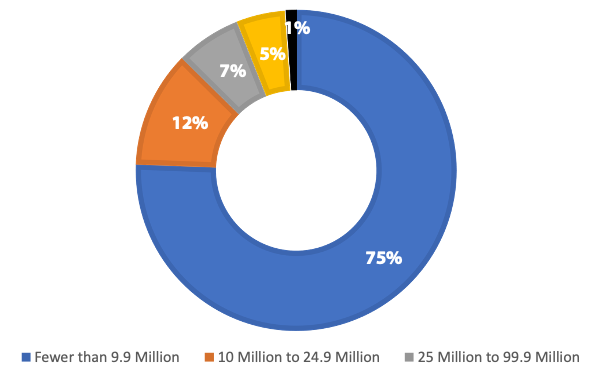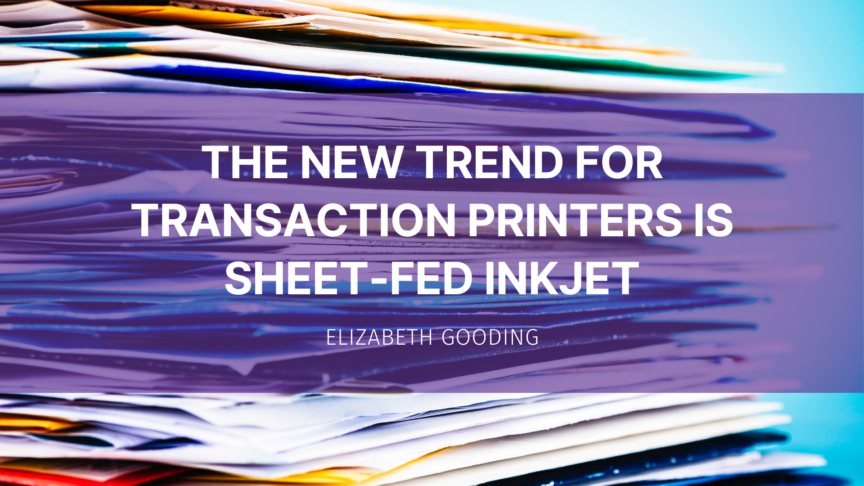Sponsored by Kyocera
Once upon a time, customer communications was a stable and growing market. Each time customers, in a range of regulated industries from brokerage to healthcare, completed a transaction with their service provider, various communications such as transaction confirmations, invoices, and statements were triggered for printing and mailing. Even most non-regulated businesses had some form of printed quotation, invoice or other notification to send to their customers periodically. These communications happened on a fairly regular schedule with predictable demand. Volume for this segment was so strong that customers warehoused dedicated letterhead, typically on rolls for larger companies, and toner presses overprinted on this stock. Printers didn’t even have to worry about the cost of paper. What a business!
Fast forward to today and the idea of laser printing on offset printed stocks seems somewhat quaint. By the turn of the millennium most large transaction printing companies had adopted some variation of the Automated Document Factory (ADF) first proposed by Gartner in 1996. The production of customer communications became increasingly efficient at the same time that regulatory, economic and consumer behavioral changes combined to continue to drive down volumes. Certain documents became easier to deliver online due to easing of regulatory constraints and consumer resistance. A decade later, the majority of transaction printing volume had been converted from toner presses and was being produced using white paper on continuous feed inkjet presses1.
All of these factors have led to market consolidation as larger printing companies buy-up or price-out smaller companies to drive volumes to onto high-speed inkjet presses. There are fewer and fewer toner presses from which to convert volume and Sean Smyth predicts that by 2026, only 4% of transaction pages will be produced on toner equipment. Does this mean that transaction printing is a dead-end market for printing companies and their OEMs? Not by a longshot.
The Rise of Sheet-Fed Inkjet
The customer communications market still represents over 40 billion annual pages in the U.S. alone through at least 2026, and the annual rate of decline has slowed, according to Smithers1. That means, even by 2026, approximately 1.6 billion pages will still be viable for conversion from toner to inkjet. This volume is likely spread across thousands of smaller printing companies and in-plant operations with lower annual volumes. In 2021, Keypoint Intelligence surveyed 364 companies producing customer communications in the U.S. and Canada and found that 75% of these companies produced fewer than 10 million communications per year3. Note that the survey asked about the number of printed and mailed communications not the number of printed pages. The wide majority, 87%, produce fewer than 25 million communications per year. The needs of this smaller volume customer communications segment is driving growth in sheet-fed inkjet installations, particularly B3 format inkjet.
Figure 1: Transaction Communications Printed Annually

Chart extrapolated from data provided in: Keypoint Intelligence 2021”Annual State of Transactional Communications Business Survey.” N=364 U.S. and Canadian firms.
The B3 sheet-fed inkjet format is particularly attractive to companies transitioning from same-format toner devices who will enable lower costs and drive higher efficiency with fewer training, financial, and logistical hurdles than they would encounter if converting to a roll-fed inkjet environment. However, even companies who have already invested in high-speed continuous inkjet equipment can benefit from the flexibility of a sheet-fed press for reprints, small jobs, application diversity, and even disaster recovery support. According to I.T Strategies, B-3 sheet-fed production inkjet sales are expected to grow from 125 units per year in 2020 to 288 by 20262. That’s a compound annual growth rate (CAGR) of 13% per year. More importantly for printing companies, between 2024 and the end of 2026, over 6 billion pages of customer communications are expected to be produced on sheet-fed inkjet equipment2.
Doing more with inkjet
Businesses with a current focus on transaction communications need to balance two divergent considerations when investing in inkjet: enabling cost efficiency for their price-sensitive customer communications clients and gaining a foothold in profitable new printing markets to maintain and grow revenue. As transaction volumes continue to slowly decline, companies serving this segment must consider where their future volumes will come from while increasing production efficiencies for their current business. A highly-affordable, full color, B3 sheet-fed press can help address both concerns. Enter the Kyocera TASKalfa Pro 15000c.
Transaction printing companies working with monochrome B3 sheet-fed toner presses in the 100 page per minute (PPM) range will find that the TASKalfa Pro 15000c is priced similarly to their current printer while delivering full color, a lower overall running cost, and around a 50% boost in running speed that can get time-sensitive communications in the mail more quickly. Plus, the cost-effective full color capabilities bring an array of new business opportunities within reach from booklets and direct mail to aspects of commercial printing and point-of-purchase signage. It opens up the potential for virtually any application using uncoated (or inkjet treated) media in weights ranging from 56 to 300gsm and sizes up to 13″ x 19.2″. With the optional banner tray, this range is extended to 48 inches. Unlike other sheet-fed inkjet formats, the multi-tray nature of the press also enables work that requires a mix of paper types in the same job.
The color quality of the press also enables the white paper efficiency that large transaction printing companies have enjoyed for years. Brand stewards will have no qualms about replacing their pre-printed letterhead with dynamically printed graphics from the TASKalfa Pro 15000c. Kyocera reports that the press can consistently hit G7 color targets on offset uncoated stock. This also opens up opportunities to replace preprinted marketing messages with dynamic, personalized messaging to boost revenue and the satisfaction of current transaction printing customers.
Kyocera also likes to emphasize their focus on finishing. ‘To build on the early success of the TASKalfa Pro 15000C we are greatly accelerating our efforts to pair the right finishing devices with the press.” says Dustin Graupman, Senior Director, Ink Jet Division. “The idea of the right devices is a direct response to what our customers are telling us will help them win. ’Of course, that’s going to be concentrated on the dominant applications in production inkjet – books, transactional print and direct mail – but we are even looking beyond those critical applications towards some very interesting lesser thought of applications that lend themselves to our capabilities.”
The productivity and reliability of the press mean that existing business can be run more efficiently while pursuing new business opportunities to enable growth. Kyocera reports that customers are running more than 2 million pages per month on the press with over 96% uptime. The TASKalfa Pro 15000c brings color inkjet within reach of the majority of smaller volume transaction printing companies and provides backup and diversification opportunities to companies who have already invested in continuous feed inkjet.
To learn more about the full capabilities of the Kyocera TASKalfa Pro 15000C and the range of “big press” features delivered in a small-press package, read also “An entry-level press offering more than you expect.”
1. Smithers Pira “The Future of Inkjet Printing to 2023” by Dr. Sean Smyth
2. I.T. Strategies, “Cut-Sheet Inkjet Market Demand Greater than Supply” March 2022
3. Keypoint Intelligence 2021”Annual State of Transactional Communications Business Survey.”


Comments
Dear Elizabeth.
My comment is about TASKalfa 15000c papersize you mentioned in your article.
According to technical specifications, this model is not be able to print B3 size.
The TASKAlfa Pro 15000c supports paper sizes between 5.5″ x 8.5″ up to 12″ x 18″. You are correct that a B3 sheet is 13.9 × 19.7 inches – so it is slightly smaller than B3, but is still listed in the general B3 category. It would be more accurate to list it as an A3+ press (11.7 x 16.5).